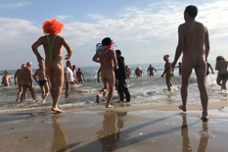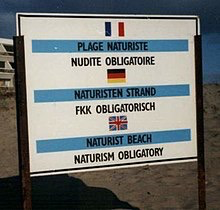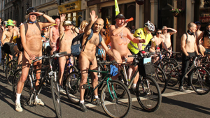Tour de France: Bums bare but masks on
On the French Mediterranean near Montpelier, Cap d’Adge, the infamous nature resort was once the go-to place for partner swapping, group sex parties, and swingers. It became notorious worldwide, attracting the rich, famous, and beautiful. Or anyone looking for a holiday with an element of sexual adventure.

This enormous, once smart but now a little jaded, beachfront holiday area is set in an avant-garde, circular building at the water’s edge. In the summer it attracts tens of thousands of French and foreign visitors every day. In its heyday, there were so many German tourists that La Poste had a designated postbox for items posted to Germany.

But, this year, Naked City, as it’s often known, was hit by more than just a few cases of sunburnt bums. Suddenly the resort showed a 30 percent COVID-19 infection rate among naturists. This was four times higher than the seven percent rate recorded among the locals in the surrounding area.

And then, ‘horror of horrors’, nudists were ordered to wear masks and practice social distancing.
Noses and mouths had to be covered even if nothing else was.
In London in June, the seventeenth World Naked Bike Ride, an annual nude cycling event to protest against car culture and oil dependence, was cancelled. The organisers recast the event as ‘#NotTheWorldNakedBikeRide’. Participants who were denied the opportunity to cycle around in the nude to attract a bit of attention had little alternative but to watch videos of former naked rides online.
COVID-19 had struck again and changed things to what is now known as the ‘new normal’.


But in Rennes, a ‘Cyclonudista’ naked bike ride around the city did go ahead, although similar events in Paris and Lyon were banned at the last minute because of the pandemic.
Tour de France: masks or no masks?
The worldwide health crisis soon had an impact on another bike ride. One of the biggest sporting events in the world, the Tour de France. This year, a mere three and a half thousand kilometre race around l’Hexagone. It attracts the world’s third-biggest TV audience after the Summer Olympics and the FIFA World Cup. And huge numbers of spectators line the route each day for the three-week event.

In the early stages of the pandemic, belief in the efficacy of face masks was patchy.
Their place in the armoury of weapons against the virus was the subject of heated arguments. The messages put out by various government health departments were inconsistent and even confusing. Some cynics pointed out that countries with adequate stockpiles promoted their use. But those who lacked stocks of masks tended to downplay their potential to prevent transmission by nose and mouth.
In the Tour, masks were made mandatory for TV interviews and on the podium.

But at first, spectators along the route were not that enthusiastic about wearing masks. Thousands upon thousands of shouting and gesticulating supporters line the road on either side from start to finish, forming a virtual tunnel of frenzied fans. Sometimes they are only centimetres away from the cyclists as they race by.
Happily, things changed when the bike riders themselves appealed to fans to keep their masks on, and they soon became de rigueur on most faces in the roadside crowds.
Mounting criticism from Feminists
This year, feminists gave a collective sigh of relief when it was announced that a long-standing Tour de France tradition would be dispensed with. The spectacle of (some say) scantily dressed young women handing over a bouquet or soft toy to the daily category winners on the podium became a thing of the past. This old tradition has succumbed to mounting criticism as being outdated and sexist.
Masks: un accessoire indispensable
In France, the wearing of masks is compulsory on public transport, and in shops, banks, libraries, and many public places including markets. The rules have been generally accepted and masks have now reached the stage of being un accessoire indispensable in some people’s eyes.
By mid-September, French media started emphasising that COVID-19 “va nous accompagner de longs mois.”
In other words, waiting for la deuxieme vague has also become the new normal. And when it arrives many experts believe it will be around for quite a while.
So, what’s next?
Well, if we’re going to beat this thing;
- we must all work together.
- We have to hope for the best—but have in place a concrete medically backed plan for how to cope with the worst.
- Wash your hands regularly and rigorously, and
- practice social distancing.
- Avoid crowds,
- close-contact settings and
- enclosed spaces with poor ventilation.
- Smother coughs and sneezes with a bent elbow or a tissue you immediately dispose of.
- Ensure good air quality in indoor settings, including homes and offices.
Stay home if you’re not feeling well and call your medical authorities for advice as soon as possible.
Keep your mask on even if you are tanning in the sun with a bare bum. And stay safe.
These are strange times we’re living through – Have you ever been to Cap d’Adge or participated in a nude bike ride? Share your views and experiences below in the comments.
Image credits
1 – 3 Cap d’Adge Wikipedia
4 – 5 Naked Bike Ride Wikipedia
6 – 7 ABC Australia TV (Director Christian Prudhomme & Caleb Ewan)






